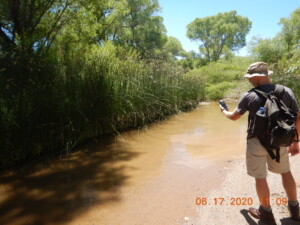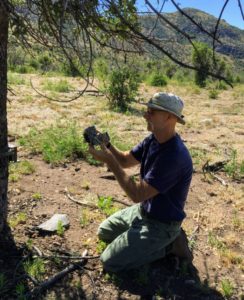Volunteers make Sky Island Alliance work possible—from restoration projects to spring surveys to wildlife tracking, we couldn’t do it without them! Today we’d like to introduce one of our newer volunteers who has become an invaluable asset over the last few months.
Brit Rosso recently joined our Volunteer team after retiring from a 35-year federal career as a wildland firefighter. His knowledge of the area, attention to detail, and go–getter adventuring attitude has made him a natural for fieldwork checking our wildlife cameras in the rugged terrain of the Border Wildlife Study. He’s also taught us about basic fire ecology and conducted a fire risk assessment at our wildlife camera sites. Yesterday, I grabbed him for a few minutes while we were out checking cameras in the Patagonia Mountains to ask a few questions.
How did you first get involved with Sky Island Alliance?
I have been supporting SIA for years through financial donations. After my retirement last spring, I was looking for new opportunities to support organizations that aligned with my core beliefs. The SIA mission is to “protect and restore the diversity of life and lands in the Sky Island region of the U.S. and Mexico.” So, when I saw an announcement from the SIA for a “Meet and Greet” open house last October, I decided to go meet the staff behind the web site. It was during that open house event where I first signed up as a SIA volunteer, and adopted a wildlife camera.
Why do you volunteer with SIA?
I became a volunteer for a multitude of reasons. One reason was that I wanted to support the critical mission of SIA in the field. I also wanted to work with like-minded individuals that have a passion to preserve and protect our Sky Islands on both sides of the border. By volunteering with SIA, I’m learning more about the Sky Island region, and how diverse it is!
Tell us about your experiences volunteering over the past few months
I had been volunteering with SIA for a few months when the Border Wildlife Study was launched. I signed up to support that effort, which just happened to coincide with the emergence of the COVID-19 pandemic. The SIA staff quickly adapted and built a pandemic risk mitigation protocol so the critical field work could continue, while keeping their staff and volunteers safe.
My favorite part about volunteering with SIA is having the opportunity to work in the field with the amazing SIA staff, and getting to spend time working in the Sky Islands. The work is so rewarding, and it directly supports the SIA mission.
How does your involvement with SIA help you connect to the Sky Island Region?
As a SIA volunteer, the opportunities to support projects in the field puts me in direct contact with the flora and fauna in our Sky Islands. By supporting the SIA staff in the collection of data, I feel like I’m filling the role of an advocate for our Sky Island region. The wildlife along our border with Mexico don’t care about our border politics. They just want access to food, water and shelter with the ability to migrate across the borderlands, so they can survive and thrive. The critical springs throughout the Sky Island region are in dire need of protection. By volunteering with the Spring Seeker program, this connects me with the landscape, including the flora and fauna that rely on these critical pools of life.
What would you like to tell the world about the Sky Islands?
One might think that the Sky Islands are all the same. As I’ve had the opportunity to visit and spend more time in different Sky Islands on both sides of the border, I’ve quickly realized that each Sky Island is unique. This is no different than islands in the sea. Our Sky Islands are separated by a sea of desert, grasslands or increasingly human development. Each “island” has its own unique set of challenges. Some of the threats to our Sky Island region are climatic change, drought, invasive species, human development and a reduction in diversity.
Another major threatis the construction of a 30’ steel barrier, right through the middle of the Region. It’s unfortunate that many citizens can’t have a civil conversation about this wall. People will quickly move into their “tribal camps” and either fully support the wall, or are totally against it. One thing we do know based on scientific data, is that this wall will become a barrier to the migration of wildlife throughout the Sky Island Region.
The Sky Island Alliance is not a political organization. They are a science based, data driven group of passionate people who utilize nationally recognized best practices to preserve and protect the Sky Island region.
What was your federal career in wildland firefighting like?
As a former wildland firefighter who spent 35 years in the service, I’ve had the opportunity to travel all over this country to fight and manage fire. I was stationed in California for 27 years, and transferred to a fire management specialist job in Tucson back in 2010. I’ve worked in diverse ecosystems such as lowland deserts, California chaparral, Alaska tundra, Hawaii rainforest, Florida everglades right up to the Sierra Nevada timberline.
I spent 21 years of my career on a Hotshot Crew, stationed at Sequoia and Kings Canyon National Parks. During that time, I did spend some time fighting fire in the Sky Island region. We were assigned to the 12,000-acre Miller Peak Fire in the Huachuca Sky Island back in 1988. In 1989 we were assigned to fight the 9,600-acre Chiva Fire in the Rincon Sky Island. In 1994 we were assigned to fight the 10,000–acre Rattlesnake Fire in the Chiricahua Sky Island.
During my fire career I also spent much of my time managing natural ignition fires and prescribed burning. I had the honor to plan and implement prescribed fires in the Giant Sequoia groves, which require fire to reproduce. It was so rewarding to see the tiny Giant Sequoia tree seedlings sprout up the following spring after a prescribed fire!
My transition from a firefighter to a volunteer with the Sky Island Alliance just feels natural. I’m still surrounded by passionate people who love their job, and the organizational missions are similar. Both organizations work hard to preserve and protect our environment for current and future generations.

Brit at the San Pedro river collecting data for the The Nature Conservancy and the Bureau of Land Management last June


